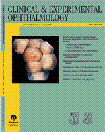Correlation between generalized and focal retinal arteriolar narrowing in an older population
Abstract
This study aimed to assess the associations between generalized and focal retinal arteriolar narrowing in the Blue Mountains Eye Study population (n = 3654 personsaged 49+ years). Summarized estimates of the average retinal arteriolar diameter, the central retinal arteriolar equivalent (CRAE) and arteriole-to-venule ratio were obtained from right eye photographs of each participant using a computer-assisted method. Focal retinal arteriolar narrowing was graded from retinal photographs of both eyes using a ‘light-box’ method. The proportion of subjects with focal arteriolar narrowing increased as CRAE decreased from the widest (2.2%) to the narrowest (7.8%) quintile (P for trend = 0.001). A receiver operating characteristic curve was constructed using CRAE to detect focal arteriolar narrowing. With the diagnostic cut point set at the 4th decile of CRAE, the sensitivity and specificity in detecting focal arteriolar narrowing were 64% and 61%,respectively. These data suggest a moderate correlation between generalized (CRAE) and focal arteriolar narrowing. However, no significant association was found between arteriole-to-venule ratio and focal arteriolar narrowing.




